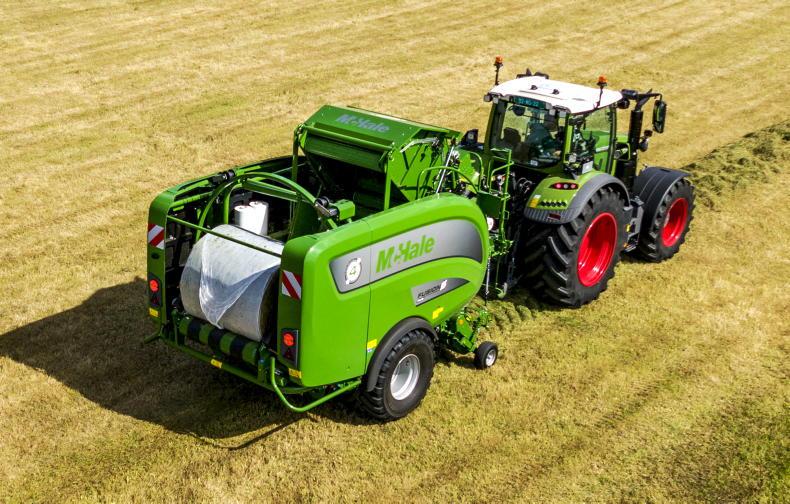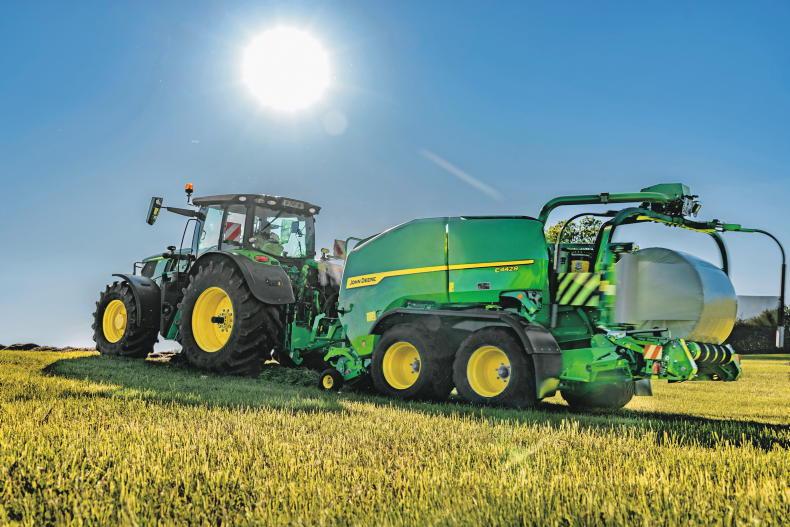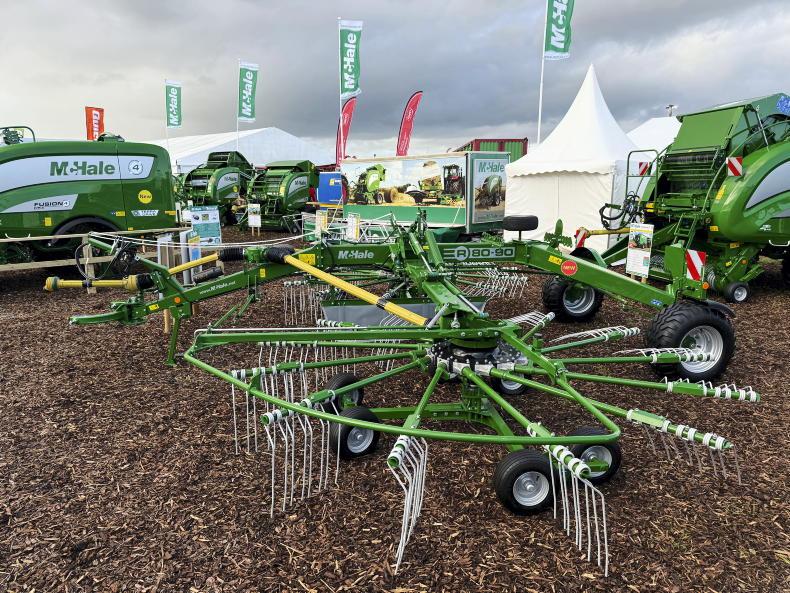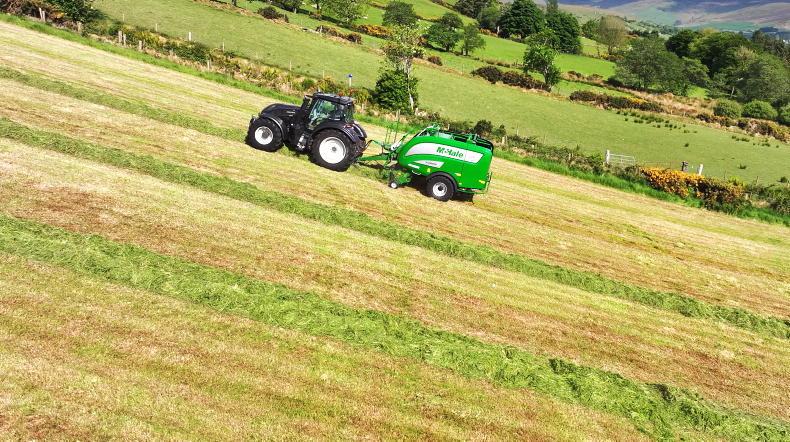When people talk about McHale, it’s recognised as a company that’s up there with the pinnacle success stories of Irish manufacturing and engineering.
McHale unveiled its first Fusion integrated baler-wrapper combination all the way back in 2001. This in itself was pioneering, as there were very few combi units on the European market.
The Fusion name soon established itself as a market leader in Ireland, with export markets growing exponentially. Today, the Fusion is without doubt the most renowned piece of farm machinery exported from Ireland.
Over the course of the last few years, competition in the baler market has really heated up.
McHale has undoubtedly been the market leader in Ireland for some time, and also has been across other countries.
New developments from manufacturers, such as Kuhn, Kverneland, John Deere, AGCO, Pöttinger and Goweil, have kept McHale on their toes.
McHale launched its new Fusion 4 range at the Ploughing Championships last year. The range is made up of three models, namely the standard, the Pro and the Fusion 4 Plus. We recently got a chance to put the top-end Plus model through its paces.
Profi-Flo pick-up
When McHale launched the new Profi-Flo pick-up, they said it would be their highest output pick-up to date – and they weren’t lying. With the new Fusion, buyers can choose between the five-tine bar cam-track pick-up, or the optional, six-tine bar camless pick-up, which has also increased in width.
Having run cam-track pick ups in our own business for the past 35+ years, we were very impressed with McHale’s camless system, and will definitely be sticking with it going forward.
With the new pick-up, we have had far fewer broken tines.
Even after the first 20,000 bales, we only had a handful of tines to replace, which was hugely impressive – totally incomparable to previous machines over the years.
The Mayo manufacturer designed the Profi-Flo pick-up to increase crop intake through more efficient crop flow. A new tapered feed channel encourages the crop to flow from the pick-up towards the rotor, and into the bale chamber - a change that has made a significant improvement.
Users of Fusion 1s and 2s, and even the early 3s, would often regard this area as having a ‘dead spot’, where certain types of grass could sit and build up. However, the new pick-up is a dream to work with and hoovers in grass like a vacuum cleaner.
In the new range, McHale fitted the pick-up with a heavier driveline to reduce chain loading.
They also introduced the Adaptive Intake feature, which was designed to allow the intake area to automatically adjust up and down to changes in material flow. This automatically adjusts the intake area to better handle uneven and lumpy rows, while reducing the chances of a blockage occurring.
The new pick-up is a dream to work with and hoovers in grass like a vacuum cleaner
Maybe it’s me getting lazy, but to speed things up when in and out of small fields, I would be asking McHale to add the option of being able to put the pick-up guide wheels into the working/transport position from the cab, whether this be through a hydraulic spool valve, or via the control terminal.
All in all, I think the total design of the new pick-up reel is a major addition to the new range. Every machine has a weak point, and if you asked me what I felt Fusion’s ‘Achilles heel’ was, I would have said the pick-up.
But, hats off, the new design coupled with the 1,000rpm speed driveline has super throughput capacity.
Gearbox
The Fusion range comes fitted with a 540rpm split drive gearbox as standard, while a 1,000rpm gearbox is available as an option.
The 1,000rpm gearbox results in an increase in PTO speed, with a reduced torque. In turn, this reduces sharp loading on the driveline, with McHale claiming it provides the clutch setting with 10% more capacity.
Similar to the new pick-up, the 1,000-speed gearbox is another big step forward for the Fusion. Any experienced driver will tell you it results in less blockages and an increased throughput capacity.
McHale recommends selecting 540rpm (if available) on the tractor for an easier restart in the case of a blockage. We found this works well and is easier on the tractor and baler.
Chopping unit
Like the outgoing Fusion 3 range, the Fusion 4 has a 25-knife chopping unit that comes as standard.
McHale claims the 25 knives provide a chop length of approximately 46mm. Again, the new range comes with a selectable knife bank.
Any experienced driver will tell you it results in less blockages and an increased throughput capacity
Essentially, there are two knife banks in the chopping unit that can be activated and deactivated individually. Various knife configurations of 0, 12, 13 or 25 can be selected depending on the user’s requirement.
A knife sensor monitors knife pressure and alerts the operator through the control console if chop quality has reduced. A primary hydraulic knife protection system protects the knives in the case of hitting a foreign object. A secondary protection system is in place on each individual knife.
Bale chamber
The bale chamber is comprised of 18 rollers, manufactured from high-grade tubular steel. Single sprocket rollers on the chamber driveside are equipped with 50mm shafts and bearings. Rollers under most loads are fitted with double-row bearings.
All rollers fitted with double sprockets are equipped with 55mm shafts and double-row 55mm bearings. The non-driveside of the bale chamber is also fitted with heavy-duty 50mm bearings.
Over the course of the past few years, McHale has significantly beefed up the shafts and bearings. The only major change to the binding system is the addition of a larger net/film brake.
McHale claims this allows up to 25% more stretch to be achieved for tighter binding, especially when using NRF.
Bale transfer
When it comes to running combination units, everyone always asks, “how long does the bale transfer take?” And the next thing they do is compare that to a Fusion.
Arguably, it was the patented bale transfer system that McHale developed many years ago that initially put the manufacturer on the map, while this feature has been key to keeping the manufacturer as the go-to machine in many markets.
To explain, for anyone who may not be familiar, when the netting is complete, the bale chamber splits horizontally. The top section of the chamber moves up, while the lower section simultaneously moves up and out, gently ejecting the bale onto the wrapping table.
Building on the transfer system, McHale has stuck with the proven vertical wrapping ring that it has become renowned for. The unit is fitted with two 750mm dispensers. Four layers of wrap can be applied in approximately 18 seconds.
With older Fusions in heavy crops with raked swathes, users often had to wait for the bale to finish wrapping before the chamber could be emptied. Thanks to the faster wrapping cycle, in most situations, this is now not the case with the new range.
A control keypad has been fitted to the rear of the machine. This is a nice touch that allows the operator to control functions, such as: wrapper start/pause, rear wrapping roller up/down, cut and hold release, work lights, index the wrapper and two customisable buttons, etc, from outside the cab.
New panel lighting has been added to help the operator to change the film in the dark. These lights are located underneath the side panels of the machine and are a great addition.
IsoBus controls
The standard Fusion comes with a basic Expert Plus control terminal, while all Fusion 4 Pro and Plus machines are IsoBus-compatible as standard.
These machines can be plugged into any IsoBus tractor connection and be operated via the tractor’s own terminal.

The Iso-Play 12-inch terminal, built by Topcon, is very user-friendly, with all functions easy to navigate through.
The units can also be operated with tractors that are not IsoBus-compatible, through the Iso-Play 7 or Iso-Play 12 console. We used the latter for our review and, apart from the terminal, we only needed an additional wiring loom.
These IsoBus control terminals are built by Topcon. Coming from the RDS Apollo terminal (labelled as the iTouch by McHale), which was used in the Fusion 3, the new terminal took a small bit of getting used to. Having tried both the seven-inch and the 12-inch terminals, I would be opting for the bigger screen.
With it, you have the comfort of splitting the screen, with a camera displaying the wrapping unit, adjacent to the machine’s controls. The terminal is very user-friendly, with all functions easy to navigate through, while the smart switching cameras are also a nice touch.
With the Fusion 4, McHale have increased the density pressure. As with the Fusion 3 Plus, these adjustments can be made through the terminal.
Maintenance
McHale fitted the range with dual-grease and oil pumps. The grease pump connects to the downward movement of the bale tip, while the oil pump connects to the upward movement of the bale tip. This applies grease and oil evenly and continuously.
McHale has successfully used this system for many years, and recently increased the size of the oil storage tank, which was also welcomed by users.
Having grown up operating Fusion 1s, 2s and 3s, the Fusion 4 is undoubtedly the next step in the right direction.
The improvements to the pick-up and the new 1,000 speed driveline are a super addition, and will definitely satisfy customers who might have felt this was formerly a weak point with previous machines.
The only change that I would personally like to see on the next generation of the Fusion is a simpler system for swapping in and out the knives.
Although it would certainly require a good share of re-engineering, we see companies such as Pöttinger and Goweil have successfully integrated this into their own combi units, where the chopping unit is located above the chamber, rather than underneath.
Meanwhile, in forage wagons, we see manufacturers offering swing-out knife banks. The system McHale has used for years is tried and tested, and without question it works.
But from an operator’s point of view, the day is coming where drivers simply won’t crawl under a machine to swap in new knives.
All in all, we were really impressed with the Fusion 4. We haven’t operated a combination unit yet with a better throughput capacity.
McHale has addressed what we would classify some of its weaker points over the years, and further enhanced the other areas. McHale is the market leader in a huge number of markets, and based on working its new model for a busy week, it would be hard to see it slipping down the chart.
Likes:
Build quality.New pick-up and 1,000 speed driveline. Speed of bale transfer.Addition of LED lighting under panels.Dislikes:
Would like hydraulic option to fold pick-up guide wheel.
With the Fusion 4, McHale have really addressed what we would classify as some of its weaker points over the years, and further enhanced the other areas.
Model: McHale Fusion 4 Plus.
Knives: 25 (selectable knife bank).
Rollers: 18 rollers (4mm thick) with 50-55mm shafts.
Net/NRF capacity: Four rolls.
Film capacity: 12 rolls (two in use, 10 stored).
Weight: 5,800kg empty.
Width: 2.76-2.94m (9’ – 9’8”)
Wheel size: 560/45 R22.5.
List price: €96,000 plus VAT.
When people talk about McHale, it’s recognised as a company that’s up there with the pinnacle success stories of Irish manufacturing and engineering.
McHale unveiled its first Fusion integrated baler-wrapper combination all the way back in 2001. This in itself was pioneering, as there were very few combi units on the European market.
The Fusion name soon established itself as a market leader in Ireland, with export markets growing exponentially. Today, the Fusion is without doubt the most renowned piece of farm machinery exported from Ireland.
Over the course of the last few years, competition in the baler market has really heated up.
McHale has undoubtedly been the market leader in Ireland for some time, and also has been across other countries.
New developments from manufacturers, such as Kuhn, Kverneland, John Deere, AGCO, Pöttinger and Goweil, have kept McHale on their toes.
McHale launched its new Fusion 4 range at the Ploughing Championships last year. The range is made up of three models, namely the standard, the Pro and the Fusion 4 Plus. We recently got a chance to put the top-end Plus model through its paces.
Profi-Flo pick-up
When McHale launched the new Profi-Flo pick-up, they said it would be their highest output pick-up to date – and they weren’t lying. With the new Fusion, buyers can choose between the five-tine bar cam-track pick-up, or the optional, six-tine bar camless pick-up, which has also increased in width.
Having run cam-track pick ups in our own business for the past 35+ years, we were very impressed with McHale’s camless system, and will definitely be sticking with it going forward.
With the new pick-up, we have had far fewer broken tines.
Even after the first 20,000 bales, we only had a handful of tines to replace, which was hugely impressive – totally incomparable to previous machines over the years.
The Mayo manufacturer designed the Profi-Flo pick-up to increase crop intake through more efficient crop flow. A new tapered feed channel encourages the crop to flow from the pick-up towards the rotor, and into the bale chamber - a change that has made a significant improvement.
Users of Fusion 1s and 2s, and even the early 3s, would often regard this area as having a ‘dead spot’, where certain types of grass could sit and build up. However, the new pick-up is a dream to work with and hoovers in grass like a vacuum cleaner.
In the new range, McHale fitted the pick-up with a heavier driveline to reduce chain loading.
They also introduced the Adaptive Intake feature, which was designed to allow the intake area to automatically adjust up and down to changes in material flow. This automatically adjusts the intake area to better handle uneven and lumpy rows, while reducing the chances of a blockage occurring.
The new pick-up is a dream to work with and hoovers in grass like a vacuum cleaner
Maybe it’s me getting lazy, but to speed things up when in and out of small fields, I would be asking McHale to add the option of being able to put the pick-up guide wheels into the working/transport position from the cab, whether this be through a hydraulic spool valve, or via the control terminal.
All in all, I think the total design of the new pick-up reel is a major addition to the new range. Every machine has a weak point, and if you asked me what I felt Fusion’s ‘Achilles heel’ was, I would have said the pick-up.
But, hats off, the new design coupled with the 1,000rpm speed driveline has super throughput capacity.
Gearbox
The Fusion range comes fitted with a 540rpm split drive gearbox as standard, while a 1,000rpm gearbox is available as an option.
The 1,000rpm gearbox results in an increase in PTO speed, with a reduced torque. In turn, this reduces sharp loading on the driveline, with McHale claiming it provides the clutch setting with 10% more capacity.
Similar to the new pick-up, the 1,000-speed gearbox is another big step forward for the Fusion. Any experienced driver will tell you it results in less blockages and an increased throughput capacity.
McHale recommends selecting 540rpm (if available) on the tractor for an easier restart in the case of a blockage. We found this works well and is easier on the tractor and baler.
Chopping unit
Like the outgoing Fusion 3 range, the Fusion 4 has a 25-knife chopping unit that comes as standard.
McHale claims the 25 knives provide a chop length of approximately 46mm. Again, the new range comes with a selectable knife bank.
Any experienced driver will tell you it results in less blockages and an increased throughput capacity
Essentially, there are two knife banks in the chopping unit that can be activated and deactivated individually. Various knife configurations of 0, 12, 13 or 25 can be selected depending on the user’s requirement.
A knife sensor monitors knife pressure and alerts the operator through the control console if chop quality has reduced. A primary hydraulic knife protection system protects the knives in the case of hitting a foreign object. A secondary protection system is in place on each individual knife.
Bale chamber
The bale chamber is comprised of 18 rollers, manufactured from high-grade tubular steel. Single sprocket rollers on the chamber driveside are equipped with 50mm shafts and bearings. Rollers under most loads are fitted with double-row bearings.
All rollers fitted with double sprockets are equipped with 55mm shafts and double-row 55mm bearings. The non-driveside of the bale chamber is also fitted with heavy-duty 50mm bearings.
Over the course of the past few years, McHale has significantly beefed up the shafts and bearings. The only major change to the binding system is the addition of a larger net/film brake.
McHale claims this allows up to 25% more stretch to be achieved for tighter binding, especially when using NRF.
Bale transfer
When it comes to running combination units, everyone always asks, “how long does the bale transfer take?” And the next thing they do is compare that to a Fusion.
Arguably, it was the patented bale transfer system that McHale developed many years ago that initially put the manufacturer on the map, while this feature has been key to keeping the manufacturer as the go-to machine in many markets.
To explain, for anyone who may not be familiar, when the netting is complete, the bale chamber splits horizontally. The top section of the chamber moves up, while the lower section simultaneously moves up and out, gently ejecting the bale onto the wrapping table.
Building on the transfer system, McHale has stuck with the proven vertical wrapping ring that it has become renowned for. The unit is fitted with two 750mm dispensers. Four layers of wrap can be applied in approximately 18 seconds.
With older Fusions in heavy crops with raked swathes, users often had to wait for the bale to finish wrapping before the chamber could be emptied. Thanks to the faster wrapping cycle, in most situations, this is now not the case with the new range.
A control keypad has been fitted to the rear of the machine. This is a nice touch that allows the operator to control functions, such as: wrapper start/pause, rear wrapping roller up/down, cut and hold release, work lights, index the wrapper and two customisable buttons, etc, from outside the cab.
New panel lighting has been added to help the operator to change the film in the dark. These lights are located underneath the side panels of the machine and are a great addition.
IsoBus controls
The standard Fusion comes with a basic Expert Plus control terminal, while all Fusion 4 Pro and Plus machines are IsoBus-compatible as standard.
These machines can be plugged into any IsoBus tractor connection and be operated via the tractor’s own terminal.

The Iso-Play 12-inch terminal, built by Topcon, is very user-friendly, with all functions easy to navigate through.
The units can also be operated with tractors that are not IsoBus-compatible, through the Iso-Play 7 or Iso-Play 12 console. We used the latter for our review and, apart from the terminal, we only needed an additional wiring loom.
These IsoBus control terminals are built by Topcon. Coming from the RDS Apollo terminal (labelled as the iTouch by McHale), which was used in the Fusion 3, the new terminal took a small bit of getting used to. Having tried both the seven-inch and the 12-inch terminals, I would be opting for the bigger screen.
With it, you have the comfort of splitting the screen, with a camera displaying the wrapping unit, adjacent to the machine’s controls. The terminal is very user-friendly, with all functions easy to navigate through, while the smart switching cameras are also a nice touch.
With the Fusion 4, McHale have increased the density pressure. As with the Fusion 3 Plus, these adjustments can be made through the terminal.
Maintenance
McHale fitted the range with dual-grease and oil pumps. The grease pump connects to the downward movement of the bale tip, while the oil pump connects to the upward movement of the bale tip. This applies grease and oil evenly and continuously.
McHale has successfully used this system for many years, and recently increased the size of the oil storage tank, which was also welcomed by users.
Having grown up operating Fusion 1s, 2s and 3s, the Fusion 4 is undoubtedly the next step in the right direction.
The improvements to the pick-up and the new 1,000 speed driveline are a super addition, and will definitely satisfy customers who might have felt this was formerly a weak point with previous machines.
The only change that I would personally like to see on the next generation of the Fusion is a simpler system for swapping in and out the knives.
Although it would certainly require a good share of re-engineering, we see companies such as Pöttinger and Goweil have successfully integrated this into their own combi units, where the chopping unit is located above the chamber, rather than underneath.
Meanwhile, in forage wagons, we see manufacturers offering swing-out knife banks. The system McHale has used for years is tried and tested, and without question it works.
But from an operator’s point of view, the day is coming where drivers simply won’t crawl under a machine to swap in new knives.
All in all, we were really impressed with the Fusion 4. We haven’t operated a combination unit yet with a better throughput capacity.
McHale has addressed what we would classify some of its weaker points over the years, and further enhanced the other areas. McHale is the market leader in a huge number of markets, and based on working its new model for a busy week, it would be hard to see it slipping down the chart.
Likes:
Build quality.New pick-up and 1,000 speed driveline. Speed of bale transfer.Addition of LED lighting under panels.Dislikes:
Would like hydraulic option to fold pick-up guide wheel.
With the Fusion 4, McHale have really addressed what we would classify as some of its weaker points over the years, and further enhanced the other areas.
Model: McHale Fusion 4 Plus.
Knives: 25 (selectable knife bank).
Rollers: 18 rollers (4mm thick) with 50-55mm shafts.
Net/NRF capacity: Four rolls.
Film capacity: 12 rolls (two in use, 10 stored).
Weight: 5,800kg empty.
Width: 2.76-2.94m (9’ – 9’8”)
Wheel size: 560/45 R22.5.
List price: €96,000 plus VAT.












SHARING OPTIONS